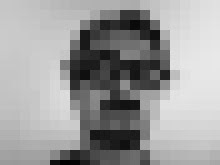Nam June Paik’s TV Buddha was produced as a gap-filler for an empty wall in his fourth show in the Galeria Bonino. The installation consists of a Buddha statue placed in front of a TV gazing at its own video image, registered by video camera.
Causing an infinite, closed feedback loop installation of which the spectator is excluded. The traditional, closed eyed Buddha, cut off from external stimuli, contemplating the inner self, is forced to interact with a media perception of the self. This conflicting, possibly incompatible, situation enhances the interaction between the two. During the 'Projekt '74' exhibition in Cologne, Paik took the Buddha’s place, suggesting the implicit antithesis between transcendentalism and technology was equally present in his own personality.
The installation Me TV is developed as a funny but critical note to the Singularity theory of Ray Kurzweil. Which claims that in the near future, humanity transcends its biological limitations by exponential evolving technologies. The theory was a main theme for an assignment given by our semester lecturer Kees de Groot.
Me TV invites the spectator to take the position of the Buddha statue and experience its conflict. On the one hand, get in a meditation state by closing the eyes and closing oneself from external stimuli. On the other hand, experience the perfect image and invoke the infinite feedback loop. With the use of a brain computer interface that measures the brain activity, the spectator is able to influence the distorted image. By achieving a meditation state, the image gets restored. An attempt to see the perfect image mostly fails. When opening the eyes, the brains get stimulated and distort the image again.

TV Buddha, Nam June Paik, 1974

ME TV, Gogbot Festival, 2010
Sources:
MediaArtNet,
M/Cyclopedia of New Media













